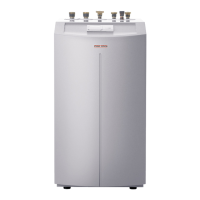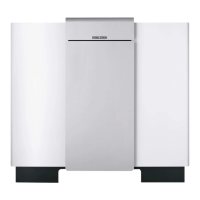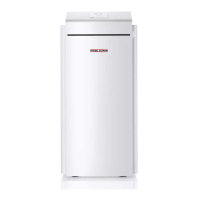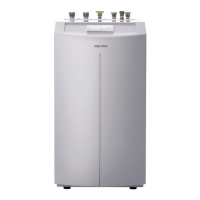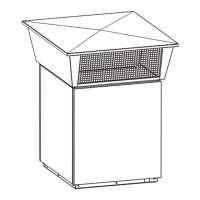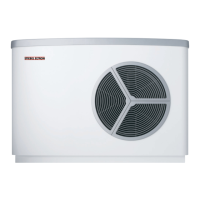OPERATION
Menu structure
18 |WPF | WPF cool www.stiebel-eltron.com
Standard setting
Buffer operation
When using a buffer cylinder, set this parameter to ON.
Summer mode
The SUMMER MODE parameter can be used to define the point at
which the heating system is to switch to summer mode. Summer
mode can be switched ON or OFF. This function offers 2 adjustable
parameters.
- OUTSIDE TEMP parameter:
Available outside temperature 10 °C to 30 °C
- BUILDING HEAT BUFFER parameter
This parameter lets you choose whether an average outside tem-
perature should be determined, according to the type of building.
You can select from 3 settings.
Setting "1": Minor insulation of the outside temperature (averaging
over a 24 h period), forexample timber construction with rapid
heat transfer.
Setting "2": Moderate insulation of the outside temperature (av-
eraging over a 48 h period), for example solid construction with
thermal insulation and average heat transfer.
Setting "3": Heavy insulation (averaging over a 72 h period) of the
outside temperature. House with slow heat transfer.
Both heating circuits (if installed) enter summer mode if the de-
termined outside temperature is ≥ than the selected outside tem-
perature; reverse hysteresis –1 K.
With fixed-value control, summer mode is disabled for heating
circuit 1.
Maximum return temperature
Setting range 20 °C to 60 °C.
The heat pump is switched OFF immediately if the temperature
at the return sensor reaches this value during heating operation.
This safety function prevents the high pressure switch from re-
sponding. No fault message is issued when this value is reached.
During DHW operation the return temperature is not scanned.
Maximum flow temperature
Maximum heat pump flow temperature for central heating
Setting range 20 °C to 65 °C.
This setting limits the flow temperature of the heat pump and the
electric emergency/booster heater in heating mode.
Fixed value operation
The heat pump return is regulated to the set fixed value. The
switching time program will then be ignored. The various posi-
tions of the program selector will then only affect the mixer circuit
(if installed). The frost protection is activated and the compressor
is switched OFF when the program selector is set to standby and
a fixed temperature has been selected. Summer logic remains
disabled with fixed temperature control. This means that the heat-
ing circuit pump is not switched off for the direct heating circuit.
Heating circuit optimal
When an Uponor DEM WP module is connected, the heating curve
is dynamically optimised for the heat demand of individual rooms.
This involves modifying the preset heating curve by up to 50%
of its initial value.
The parameter HEATING CIRCUIT OPTIMAL is only displayed when
the parameter BUFFER OPERAT is set to OFF and neither a mixer
sensor nor an FE7 remote control are connected.
The parameter HEATING CIRCUIT OPTIMAL can be set to ON or OFF.
The default value is OFF.
This parameter may only be set to ON when an Uponor DEM WP
module is connected.
This function is only active in Comfort mode, ECO mode and Pro-
grammed operation.
Frost protection
To protect the heating system from frost, the heating circuit pumps
are started at the selected frost protection temperature; the re-
verse hysteresis is 1 K.
Remote control FE7
This menu item is only displayed when the FE7 remote control is
connected.
Heating circuit preselection
Remote control FE7 can be selected for both heating circuits.
This parameter lets you choose on which heating circuit the re-
mote control is to act. Depending on the remote control prese-
lection, you can query the actual room temperature under INFO/
SYSTEM/ROOM TEMPERATURE.
Room influence
Standard setting 5, adjustable from ---- via 0 to 20 Dashes (----)
in the display:
With the FE7 remote control connected, the room temperature
sensor only serves to record and display the actual room temper-
ature; it has no influence on the actual control. Only in automatic
mode can the room temperature for heating circuit 1 or 2 be
adjusted by ± 5 °C. This set value adjustment applies to the then
current heating time, not to the setback time.
At the same time, setting "0 to 20" serves to control the room tem-
perature-dependent night setback. This means that the heating
circuit pump is switched off at the point of changeover from the
heating into the setback phase. It remains off, until the actual room
temperature falls below the set room temperature. After this, the
system continues to regulate in weather-compensated mode.
If you want the room temperature to be taken into account, set
the room temperature sensor influence to > 0. The room sensor
influence has the same effect as the outside temperature sensor
has on the return temperature, except that the effect is 1 to 20
times greater, depending on the factor set.
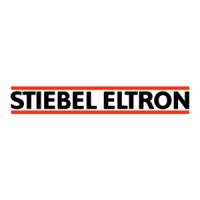
